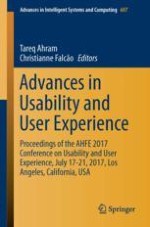This book focuses on emerging issues in usability, interface design, human computer interaction and user experience, with a special emphasis on the research aimed at understanding human-interaction and usability issues with products, services and systems for improved experience. It covers modeling as well as innovative design concepts, with a special emphasis to user-centered design, and design for special populations, particularly the elderly. Virtual reality, digital environments, heuristic evaluation and feedback of devices’ interfaces (visual and haptic) are also among the topics covered in this book. Based on the AHFE 2017 Conference on Usability & User Experience, held on July 17-21, 2017, in Los Angeles, California, USA, the book describes new findings, research methods and user-centered evaluation approaches.
